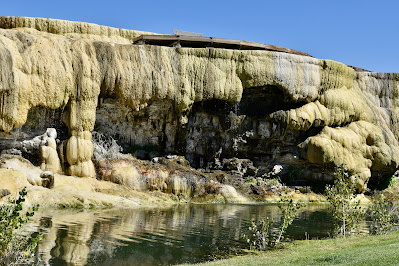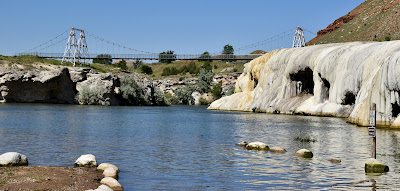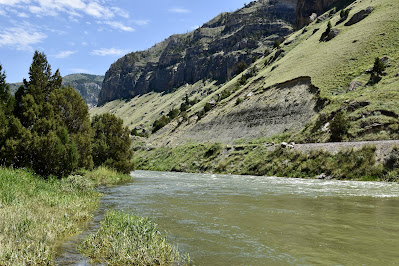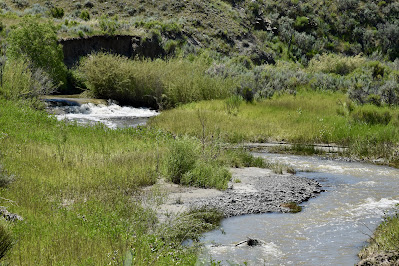Hot City, Rendezvous art, Wyoming!
Greek for “hot city”, the name, Thermopolis, fits the reality. The reality, however, does not quite jibe with what my imagination conjured when I first heard about the place. It was a fellow RVer encountered quite a few years back in Grand Junction that got me curious about the place and its hot springs.
Among the tidbits of knowledge I have acquired since getting there is that the springs were ceded in a treaty with Indian tribes with the proviso that they remain open to the public. That “open” category has been fulfilled with a public bathhouse that allows soakers to immerse themselves in their choice of an indoor or an outdoor pool for 20 minutes at a time at no charge.
For those who want to be in more hot water, so to speak, there are two private enterprises that happily accept, nay require, an admission fee.
In addition to our soaks in the public pool, we chose Hellie's Teepee Pool & spa. In truth, the main building is a dome; the name refers to the previous building that burned some years back.
I must say our soak at Hellie's was pure awesomeness. We found the small pool that suited us to a "T" and settled in to savor relaxation. Yes, I do know how to relax; I simply prefer to keep movin' & doin'.
At any rate, after all the relaxation I could take, I thought to check out the steam room. Boy howdy, that was something else! When we drew back the curtain to peer within, we actually recoiled! I had never encountered a sulfur steam room, but I guarantee I won't pass one up any time I do.
One of us refused to enter the inner sanctum, but I took to it like a duck to water. Amazing experience!
Fellow soakers, new cousins . .
We did meet some interesting fellow soakers, such as the small vacationing family from Hamburg, near where the señor's grandfather was born. And speaking of family history (ha ha, I can get it in anywhere), I have been contacted for the first time by a relative from the Wuehrmann line in Germany, a woman who found me via my Ancestry.com family tree. It is very exciting because we have been unable to trace that line further back, and she was able to fill in some blanks for me, and I for her.
Although anchored by the mineral-laden water flowing from deep within the Earth, Hot Springs State Park is more than just that. The Bighorn River flows through the park and the middle of town after mysteriously being transformed from the Wind River prior to its arrival downstream from the Wind River Canyon. I can't explain the name change, nor have I read anything that actually does explain it. It's one of those things that one must accept just because.
Other things we enjoyed there were the expansive grassy grounds shaded by tall trees and fascinating huge convolutions of ancient mineral deposits, inactive geyser cones & mineral springs - Yellowstone without the people . . .
. . . and fun with a localish family we met. A very enthusiastic bunch of youngsters with grandma & great, they were excited to share with us the sighting of a water snake, here making the acquaintance of a dragonfly . . .
. . . and to feed the fish so I could take even more pictures. I didn't even know there were fish in that pond until the children commenced to create chaos.
. . . and took a second drive out through the buffalo pasture where we finally got a sighting of the herd that resides out there, although their distance was a bit of an impediment to good photos.
As long as we were in the neighborhood . . .
. . . and since we were told about a unique exhibit at the Whitney Art museum in Cody, we decided it would be well worth the drive to check it out. Five museums are encompassed within the Buffalo Bill Center of the West.
The Whitney Western Art Museum happens to be featuring a special limited exhibit of paintings by Alfred Jacob Miller. His work is thought to be the only artistic representation of the gatherings in the 1820s & 1830s of fur trappers, traders & Indians known as mountain man rendezvous.
Miller was employed by a Scottish gentleman to accompany him into the Rocky Mountains in 1837, during which Miller made multiple sketches. He later used his sketches to produce a wonderful series of watercolors and pen & ink washes to portray those gatherings.
I was already familiar with his work, but it was quite a treat to view the originals and in context with the explanations that he provided; however, we were not as impressed by the curator's notes. They seemed at times dismissive of his style that tended to romanticize the experience.
Miller's patron, William Drummond Stewart, born 1795 in Perthshire, Scotland, fought at the Battle of Waterloo against Napoleon, and later made seven trips to the American Rocky Mountains before he employed Miller to accompany him to chronicle the experience.
After the death of his elder brother, Stewart returned to manage the family estate, Murthly Castle. It was there that Miller joined him to complete his works from memory and from his sketches. The artwork often featured Stewart as the primary subject; the paintings were displayed at Murthly as a way for him to regale friends with tales of his journeys, which must have been seen as exotic.
In addition to scenes at and around the rendezvous site at Horse Creek & the Green River, Miller depicted landmarks along the route taken by their train of 30 wagons from what is now Kansas City along the route known as the Sublette Trace via Fort Laramie & South Pass - geographic monuments that became familiar to later pioneers on the Oregon Trail, such as Chimney Rock, Devil's Gate, Independence Rock & Scott's Bluff.
A number of Miller's works were exhibited twice in 1839 to glowing reviews at the Apollo Gallery in New York prior to his time at Murthly Castle where he completed the works.
We also perused two of the other facilities in the complex: the Draper Natural History Museum - excellent! - and the Plains Indian Museum - interesting but repetitive and I was put off by the portrayal of Plains Indians and their mounts in total drab coloration, said to avoid stereotyping. In my opinion, that was absurd and offensive: Reality is not stereotyping. Plains Indians had/have dark skin and dark hair and their horses were of various coloration with dark manes & tails; that is reality.
Back roadin' . . .
Returning from Cody, we opted for the "scenic route" (as if everything here isn't scenic), or at least a different route from the one that took us there. As we turned on to a back road off another back road, we were happy to find an intriguing badlands area that gave us a chance to unlimber our limbs with a hike off and gone out there.
A set of constructed steps got us partially into the depths where we wandered at will . . .
. . . and where it became obvious that at least one bighorn sheep was sharing the space with us, although he managed to remain out of sight.
What a wondrous time we had out there as we were surprised at every turn by the scenes around us.
Meanwhile, back at the ranch . . .
. . . Super high water levels made shore fishing around Thermopolis unfeasible; everything was far above the usual channels, as in this boat ramp parking lot that is awash . . .
Guides with drift boats are available for fishing the river; however, we did not avail ourselves of such, nor did we even contemplate a whitewater rafting expedition through those class 5 rapids. . . in fact, the situation is so extreme that the rafting company has instituted new guidelines that include no one under age 16, rafters have to have previous experience with class 3 & 4 rapids and must be able to self-rescue.
High water made for some spectacular rapids through the stupendous Wind River Canyon. (an aside here: above Thermopolis, the beautiful river is called Wind River, but for no reason that makes the slightest sense, it is the Bighorn River after its exit from the canyon.).
We did drive through to admire the canyon and its mighty waterway. The steep walls barely allow for a two-lane highway and a rail line, and even then, passage makes tunnels necessary.
And we enjoyed much of the Bighorn: same river/different name & temperament.
Legend Rock . . .
We drove to view glyphs pecked into a long vertical cliff site, some more than 10,000 years ago. A Wyoming state site, Legend Rock consists of about 300 figures on 92 panels spread along the abutment just above Cottonwood Creek's bottomland.
The prehistoric petroglyphs were unusual and interesting.
I would think this one depicted a buffalo but for the fingers and toes.
Some had humanoid figures within figures . . .
. . . and this appears to be a person falling, but why the extra appendages?
And of course later folks wanted to make their mark. Unfortunately, the historic site has sustained a good bit of damage, both natural and human-caused.
Cottonwood Creek itself was attractive enough that we tromped our way through a very buggy overgrown area to get to it. From everything we have heard, general conditions are unusual, with high lush grasses and other vegetation plus more than normal standing and running water resulting from heavy snowpack.
It was impossible to see the ground surface, so we made our way slowly and noisily to alert any snakes that might be lurking.
How could we resist taking the Cottonwood Creek road beyond the Legend Rock site? The countryside is absolutely stunning everywhere one looks. And of course there are the ubiquitous pronghorns everywhere . . .
. . . and what a surprise to come upon another small flock of sandhill cranes (These were stained just like the last ones we saw), and that time, I got some photos of them.
It seemed as if that road atop a miles-long mesa peninsula with Cottonwood Creek off one side and Owl Creek off the other side might go on forever; however, our traverse of it stopped at a fenced pasture that was posted with a "No trespassing" sign, so we turned back there.
Not to be deterred with our explore, we found another road that led us up and over the Hamilton Dome oil fields and down to the Owl Creek drainage.
In the midst of the oil field, we called a halt at a most unusual stream. It had a beautiful green hue with streamers of algae undulating in the current, and gave off the tell-tale sulfurous odor of mineralized water.
Couched down at the bottom of its steep banks, it was difficult to get to, but the señor managed finally to reach the water to judge its temperature: 98, he said.
Owl Creek's valley was wider and even more picturesque than Cottonwood Creek on the other side of the mesa. And always, there are mountains: range after range into the distance. There, we were looking toward the Absarokas to the west and the Owl Creeks to the south.
We discovered later that our wander was taking us through a unit of the huge Padlock Ranch. The ranch was established in 1943; whether the picturesque schoolhouse remains in use is unknown to me, but the building is lovely in and of itself and sited beautifully on a grassy plain.
Our route was also through sections of the Arapaho & Shoshone Indian reservations. At the Owl Creek Reservoir, we again found high water conditions, with trees that are usually on dry land far out in the lake.
The Owl Creek Mountains, at least in that section were much less rocky & precipitous than most of the ranges we have seen in that section of Wyoming - and stunning, especially as the cloud shadows moved over the slopes.
Numerous abandoned farm & ranch headquarters dot that landscape. After all, 30 degrees below zero for months at a time! How do they do it?








































































































6 comments:
What an interesting trip you've taken me on. I'd love to find someone who would like to go on the trip around that country with me.
I think some of the petroglyphs looked like aliens!
azlaydey, I know you'd love it.
K Davenport, of course we are in agreement!
I've always loved shapes. U know me well😊
Lots of shapes there, whatever they denote.
Post a Comment